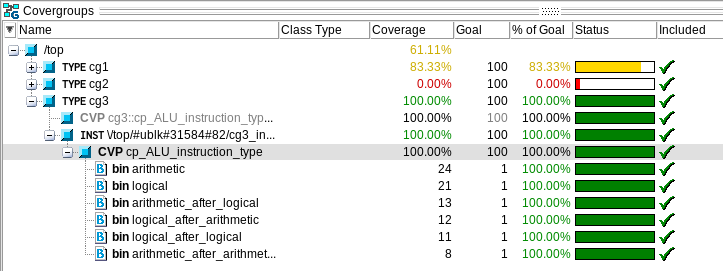More on bins
The configuration of the bins has a huge influence on the coverage. This makes constraining the bins a delicate job. SystemVerilog therefore offers quite some flexibility to define the bins. Below, a couple of features/techniques are highlighted.
Explicit bins
bins a = {1, 2};
Bin a is hit when the value is 1 or 2.
bins b[3] = {1, 2, 3, 4, 5, 6, 7, 8, 9};
Bin b is an array of width 3. As the enumeration shows more than 3 values, SystemVerilog dictates an equal distribution of the values to the number of elements in the array:
b[0] <= 1, 2, 3; b[1] <= 4, 5, 6; and b[2] <= 7, 8, 9;
bins c[3] = {1, 2, 3, 4, 5, 6, 7, 8, 9, 10};
In case of an indivisible number of elements, the final bin takes the remainder:
c[0] <= 1, 2, 3; c[1] <= 4, 5, 6; and c[2] <= 7, 8, 9, 10;
bins d[] = {1, 2, 3, 4, 5, 6, 7, 8, 9, 10};
When an array is NOT given a size, 1 bin is made for every value in the list.
Luckily you don’t have to be very explicit. Ranges can be written with a shorter notation.
bins e[] = {1, 2, 3, 4, 5};
bins e[] = { [1:5] };
Bins for transitions
All the bins that were shown up until this point were targeted at certain values (or ranges of values). Next to these options, also transitions can be tallied. The question they aim to answer is: How many times was value X seen, being followed by a value Y ?
covergroup cg3 @(posedge clock);
cp_ALU_instruction_type: coverpoint gb_iface.instruction[5] iff(gb_iface.valid) {
bins arithmetic = {0};
bins logical = {1};
bins arithmetic_after_logical = ( 1=>0 );
bins logical_after_arithmetic = ( 0=>1 );
bins logical_after_logical = ( 0=>0 );
bins arithmetic_after_arithmetic = ( 1=>1 );
}
endgroup

In the example above, coverpoint cg3 again monitors the type of instruction that is being executed in the first two bins arithmetic and logical. The next 4 bins count how often one type of operation is followed by a certain type of operation.
Note that the sum of all types of operations is 45, but the sum of transitions is only 44.
Bins for transitions can also be defined in a number of ways.
covergroup cg4 @(posedge clock);
cp_ALU_instruction_type: coverpoint gb_iface.instruction[5:3] iff(gb_iface.valid) {
bins add = {0};
bins adc = {1};
bins sub = {2};
bins sbc = {3};
bins dna = {4}; /* note the name ! */
bins rox = {5}; /* note the name ! */
bins ro = {6}; /* note the name ! */
bins pc = {7}; /* note the name ! */
bins f = ( 2 => 0 => 1);
}
endgroup
Bin f adds another transition: it counts the number of times a SUB is followed by an ADD which is then followed by an ADC.
Bin g combines ranges with transitions. It counts how often an arithmetic operation is followed by a logical operation.
bins g = ([0:3] => [4:7]);
In the next example a shorter way of description is shown.
bins h[] = (3=>3=>3=>3=>3);
bins h[] = (3[*5]));
No ordinary headache
bins i = (3[* 3:5]);
Bin i is hit when value 3 is followed more threes, but only when the total is 3, 4, or 5: 3=>3=>3 or 3=>3=>3=>3 or 3=>3=>3=>3=>3 are ok
Bin j is hit when value 3 is followed two more times but there might be other values within.
bins j = (3[->2]);
Final word
Given the simple DUT that is used for these examples, some of them seem a little overkill. Please, keep in mind that this is purely for educational purpose. To illustrate these concepts it sometimes is easier to simplify too much, but the actual implementations/functionality looses its sense 😉